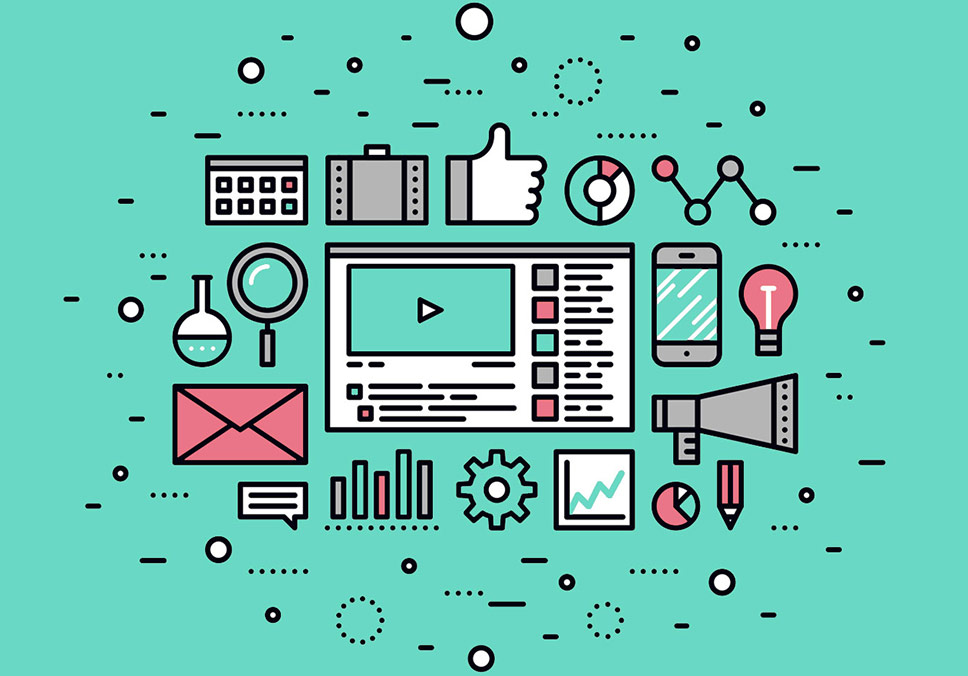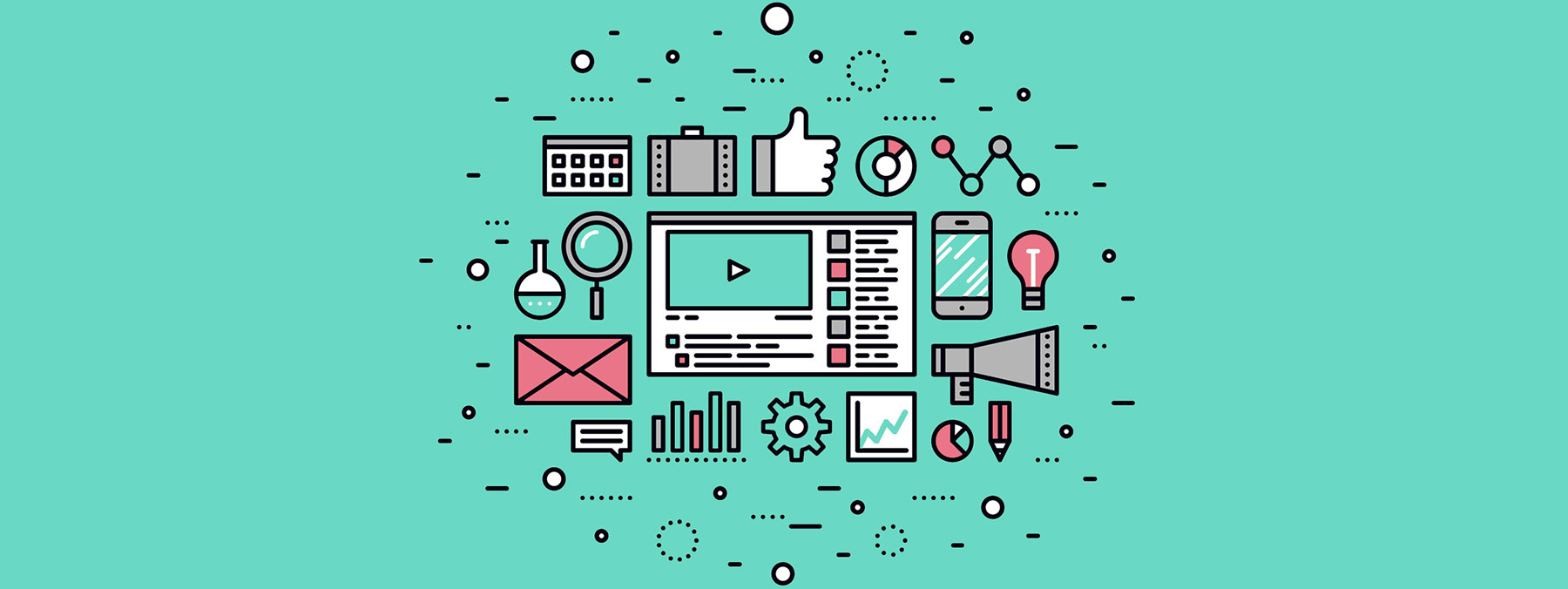In this article, we outline the basic formula for a sales funnel, as well as some cool technology you can use to boost its overall performance. Then we will get into the nitty-gritty of what sales funnel variations you can use to create the perfect B2B sales funnel recipe.
What is a sales funnel?
Technology has evolved, and the sales funnel has changed along with it. This article will take a look at the basic recipe for the sales funnel, as well as its most notable alternatives. We will then explore how adopting the benefits of each variation means the sales funnel can remain alive and kicking.
The sales funnel is a visual representation of the process a potential buyer goes through on their way to becoming a fully-fledged buyer. The sales funnel stages depend on a business’ interpretation of the funnel and their own sales model. However, it often adheres to three main sections; the top, middle and bottom.
The traditional Awareness, Interest, Desire, Action (AIDA) sales funnel, was the vision of American advertising and sales scholar, Elias St. Elmo Lewis, all the way back in 1898. The AIDA sales funnel outlines that as leads move through the stages; they learn more about your brand and develop positive feelings about your product, which compels them to act. The sales funnel aims to help companies identify “how and when to communicate during each of the stages. Consumers use different platforms, engaging at different touchpoints and requiring different information throughout the stages from various sources”.
Another essential part of the sales funnel is understanding the definition of a Marketing Qualified Lead (MQL) and a Sales Qualified Lead (SQL). A qualified lead is the crucial handoff point between marketing and sales, so the teams must agree on the terminology. Every company’s definition should reflect a combination of traits and actions that indicate a lead is both a good fit for your company and ready to talk to a salesperson.
What are the sales funnel stages?
Each stage of the sales funnel should attract relevant customers and then filter them down to the goal of purchasing.
Top of the funnel:
When your lead first becomes aware of your product and brand. Brand Awareness is the “extent to which a brand is recognised by potential customers and is associated with a particular product.” At this stage, your marketing team is creating content to boost your brand awareness. While your sales representatives educate potential leads about your product/service, rather than pushing a sale.
It would help if you researched to figure out whether your audience is online or offline. This research will influence what content you are creating for your customers and what channels you use to grab their attention. Just keep in mind that the B2B buying journey is more extended than B2C (business to customer). Not everyone who engages with your company is ready to buy or move through the funnel. However, top of the funnel marketing helps capture people who aren’t prepared to buy today but might be at a later point in time.
Middle of the funnel:
Your lead now becomes a marketing qualified lead. You can engage and ask questions that help you prove your product is the right fit for them.
At this stage, your lead understands their problem and is looking for a solution. The potential customer discovers more about your services and the benefits of purchasing from you. If they do determine you’re the right fit for their needs, they will then proceed to the next stage.
Remarketing is a useful tactic at this stage. It targets customers who previously visited your website and pushes them to make a purchase. Remarketing can also target people who have already purchased from you, encouraging them to buy again. Qualified leads can highlight their interest by filling out forms, signing up for an account or subscribing to your newsletter, in other words, voluntarily giving you their personal information.
Bottom of the funnel:
Both marketing and sales teams should work together to snare the lead’s interest and make sure that their engagement remains high enough to commit to buying.
In B2B sales processes, leads can also commit to online purchases with minimal contact from sales. Low touch sales are where a brand can build and market a product with automated sign-up, payments and invoices. So there’s minimal, or no sales support required.
When your prospect has completed a purchase, this doesn’t mean your engagement with them should be over. Staying engaged with customers after they exit the bottom of the funnel is what turns one-off buyers into repeat customers. You convert existing customers into advocates for your brand, where they’ll then recommend your brand to others.
How to create a sales funnel
1. Define your goals
It makes it a lot easier to work on your sales funnel if there is a clear vision for the business; do you want to grow? What products do you want to sell? Is the aim to diversify your clientele? Once you have figured out what your primary business goal is, you can begin to plan out the rest of your sales funnel strategy.
2. Outline your buyer personas
Buyer personas are fictional, generalised representations of your ideal customers. Creating an analysis of who you think your customers will be, will help you generate relevant content, product development and frame future engagements. Buyer personas will help you tailor your sales and marketing strategies to the needs and desires of a specific group of people.
3. Analyse your customer’s behaviour
Customer behaviour analysis is a review of how customers interact with your company. Customers are separated into buyer personas based on their common characteristics; then, you observe them along the customer journey to record how they engage with your brand. Organise your research around questions such as; what problems are your customers trying to solve? What channels are used?
4. Create marketing collateral
The next step is to create a place where potential customers can research and purchase your service. Marketing collateral describes a compilation of different media types, helps to improve the sales of your product or service.
Collateral includes ads, websites, landing pages, sales emails, pitch decks, PDFs and downloadable guides, case studies. Marketing collateral runs parallel to your brand’s primary advertising and contains a call to action; a line of text or image which urges your customers to take action. Your content should focus on outlining the details of your products and services, while also compiling reasons why your customers are making the right choice by choosing you.
What content should you use for a sales funnel?
Now you have the foundational framework for your sales funnel; the next step is to create content. It’s essential to create content with relevant keywords for your buyer personas as well as considering which tactics and channels are best for each step.
Top of the funnel:
Content can connect your customer to the company, and help customers feel confident in choosing you. 68% of consumers feel more positive about a brand after consuming content from it.One way to draw in attention is to use your knowledge from researching your audience to create tailored, high-quality content that will answer their problem.
This can involve:
- Blog posts: creating regular, relevant posts will help educate website visitors and encourage them to learn more
- Ebooks
- Infographics
- Video walkthroughs
You want to show your lead: why your solution matters to them, how they can use it, and what positive outcomes can be delivered if they do.
Middle of the funnel:
Now you can foster a relationship with customers, creating content that emphasises you’re can provide solutions to their issue. Companies with a refined middle of the funnel engagement and lead management strategy see a 4–10 times higher response rate compared to generic email blasts and outreach.
The middle of the funnel may be the most important, as customers will remove companies from the running if they don’t appear suitable.
The most effective types of content in the middle stage comprise of:
- White papers: of the top three content requests from B2B buyers, a white paper comes in first with 78% requesting this type of content.
- Case studies: these prove the value of your brand because they show how someone else has benefited from your service.
- Webinars: these digital seminars can showcase your expertise in a specific area while offering valuable information to potential clients.
Bottom of the funnel:
The bottom of the funnel is when it’s necessary to reaffirm customers purchase through action-oriented content. This type of content needs a clear message and be tailored to the customers’ unique problem.
This includes things like:
- Trial offers
- Demos
- Discounts
Creating a varied and robust content library will ensure you have the resources to attract the right customer personas and move them through the sales funnel.
Lead nurturing tactics for your sales funnel
Surprisingly, there is more to the sales funnel than just content, SEO and an excellent framework! Lead nurturing is the process of building relationships with your buyers at every stage of their buying process (and your sales funnel). According to Forrester Research, prospects wait until they are 65% to 90% of the way through their journey before approaching a vendor.
The top of the funnel is about generating leads. The middle is where you nurture those leads, and the bottom is about turning leads into concrete sales. If each stage is successful, then a lead will proceed to the next section. Your nurturing campaign should use all the research and information you gained through audience research and creation of your buyer personas. These reports will help you tailor your interactions with customers and ensure you are delivering a high-quality level of engagement.
Trying to deliver unique and specialised content to everyone who passes through your funnel would be mission impossible for anyone. Instead, this is where segmentation comes in. Segmentation is the process of defining and subdividing a broad audience into identifiable segments with similar needs, wants, or demand characteristics. Throughout your nurturing campaign, tracking interactions and measuring how and when you’re successful, this will help your business to decide what works best for you (and your customers).
Effective lead nurturing tactics include tactics like content marketing, email marketing, telemarketing, ads, and using social listening to understand what your customers are talking about. Adapting your lead nurturing tactics is all about being inquisitive and working to understand why leads behave the way they do, how your marketing affects them.
How technology has changed the sales funnel
The evolution of the sales funnel can be attributed to the fast-moving influence of technology. Modern marketers become successful because they understand that the customer journey is changing and they recognise the pressure to adapt their strategies in response to new technology.
The sales team is no longer in control of how, where, and when customers access brand information. Instead, marketing teams must also work to provide customers with the relevant content, on the right channels, at the appropriate stage – which is not an easy task! However, that’s where new marketing and sales technology can come in handy.
Artificial Technology and Marketing Automation
Artificial Technology (AI) has the potential to impact the customer journey and success of your sales funnel. AI software is an efficient solution to spot trends in customer data without human subjectivity. It can score leads more accurately and automatically, enabling sales to focus their attention on qualified leads. AI software also frees up the time of the marketing teams so they can engage with potential customers and gain a deeper understanding of what their target audience wants.
AI chatbots are another practical application and can complement your sales funnel process. Your sales team can talk and qualify potential customers efficiently. Intercom found that leads coming through live chat were of higher quality and 82% more likely to convert. ASOS, a fashion retailer, saw a 300% increase in sales after investing in Messenger chatbots. Most customers, including B2B customers, would prefer to use instant communication rather than email or phone. For example, research from Twilio found that 90% of people in North America, Europe, and Asia want to message directly with businesses.
If you’re going to stay relevant and ahead of your competitors, you need to rethink your current digital strategies. Start thinking about how you can facilitate customers to reach you through a multitude of channels.
High-level marketing personalisation; adapting your message and method of engaging with customers is now a necessity. Modern customers expect a personalised and tailored sales response and over 91% of consumers say they are more likely to shop with brands that recognise them and provide relevant offers. Marketing automation can complement your personalisation strategy, by freeing up time spent on small repetitive tasks. An automated CRM can send personalised emails and follow-ups, while behaviour-triggered emails, send a real-time email reaction based on how your customers are using your website.
Technology can assist in creating a clear sales funnel where you know where your prospects are every step of the way. So, you have a clear idea of what content and engagement they need to move to the next stage.
Six Variants of the Sales Funnel
Now let’s dive into the depths of six key sales funnel variations. Each adaptation presents an innovative solution to how we can improve the sales funnel, but the traditional sales funnel can remain relevant when taking influence from these new variations.
AIDA Sales Funnel
Let’s start with the ‘traditional sales funnel’ created by Elias St. Elmo Lewis, based on his formula for a successful advertisement;
“The mission of an advertisement is to attract a reader so that he will look at the advertisement and start to read it; then to interest him so that he will continue to read it; then to convince him so that when he has read it, he will believe it. If an advertisement contains these three qualities of success, it is a successful advertisement.”
This motivation to make a purchase relies on:
- AWARENESS of a product or service
- INTEREST in the product’s benefits
- DESIRE for the product
- ACTION purchasing the product
Awareness Stage
The top stage of the funnel is when your lead has a specific problem and is looking for trusted providers of the relevant information.
Interest Stage
The interest stage revolves around keeping your prospects attention and building interest around your product or service. You are also encouraging your prospects to inquire further about the benefits you can deliver. Your prospects now understand their problem and are searching for a solution.
Desire Stage
The transition from a prospect becoming ‘interested’ in your product, to them developing an emotional desire to purchase from you, signifies the desire stage. Marketing Qualified Leads now turn into a Sales Qualified Leads and are handed to your sales team for them to encourage a purchase.
Action Stage
The action stage is the ‘call to action’ phase of the funnel; this is when your prospect purchases your product or service.
The traditional sales funnel is the main reference point for developing new innovative strategies on how businesses should frame and monitor their sales process.
Sales Flywheel
The sales flywheel has resurfaced as a new innovative way to think about your sales and marketing processes. Invented by James Watt over 200 years ago, the flywheel is a wheel or disc on an axis. The amount of energy stored within depends on how fast you spin it, how much friction there is, and the composition of the wheel itself.
The flywheel marketing framework is a process which allows you to research, plan and reach customers in all stages of their customer journey. The cycle structure means that one thing impacts another and keeps the process of spinning and building momentum going.
Attract
Attracting is about using your brand expertise to create content and conversations that start meaningful relationships with the right audience.
Engage
Engaging is about building lasting relationships with customers by providing real solutions that align with their problems.
Delight
Delighting is about providing an experience that adds value, empowers them to reach their goals, and then become promoters of your brand to others.
(Source: HubSpot)
So, how can the sales funnel learn from this process?
The flywheel places potential customers at the centre of your business while marketing, sales and services revolve around them, not the other way around. It challenges brands to shift the way they think about success and has empowered customers to choose companies who will provide the most value. The flywheel helps to emphasise that even once a customer purchases from you – that is not the end to their journey, there should be no ‘exit’ or ‘bottom’ for them to fall out of. So when using the sales funnel, this perspective encourages you to remember to keep nurturing leads, long after converting.
Consumer Decision Journey
McKinsey & Company presented an innovative new take on the sales process, using their findings from empirical research with 20,000 businesses in the US, Germany and Japan. McKinsey recommended a loop model instead of the usual straight-line approach to the customer journey, but the process was broken down into four stages:
Consideration
Customers consider several brands while on the search, believing that one can fulfil their needs and provide solutions to their problems.
Active evaluation
Customers then evaluate the brands by researching more about them. Brands are removed from the running, depending on their pros and cons.
Buy
Customers decide to go for the one brand that meets their needs and commit to making a purchase.
Post-purchase experience
This stage explains what happens after the customers complete the purchase. If they are satisfied, they rate and recommend the product to others. This word-of-mouth marketing forms the core of the loop within McKinsey’s Customer Decision Journey.
The sales process isn’t just about having an informed salesperson, an efficient call centre, or a great site. As David Edelman and Francesco Banfi from the McKinsey & Company argue ‘it’s about having ALL of those things working together like a relay team handing off the customer from one touchpoint to the next in a smooth way. If you are not thinking about that complete customer journey, it’s hard to understand your customer.’ The way that customers research and buy from brands is always under transformation, and the shift in consumer decision making means that brands also need to adjust their sales strategies.
So, how can the sales funnel learn from this process?
The change in customer thinking is an opportunity to develop your own sales funnel and your understanding of your target audience, allowing your brand to be in the right place to deliver high-quality information.
Customer Journey Hourglass
Transforming the visual representation of the sales funnel is another method of approach. Rather than a funnel that tapers and ends once a customer makes a purchase, the hourglass framework continues after the purchase, helping to strengthen your relationship with customers.
Top Of The Sales Hourglass
Step 1: Prospect engagement
As with the sales funnel, the first thing will be to generate your leads. Then you can start learning about your prospects’ problems. You’re listening more than talking and taking notes of how you can help your potential customers.
Step 2: Solutions alignment
As you move toward the centre, you can start to bring in experts and customer success managers to engage with your potential customers. They can ensure that your solutions are aligned with your prospect’s budget and needs.
Bottom Of The Sales Hourglass
Step 3: Implementation
This stage is vital for the goal of long-term customer retention. Yet traditional sales funnels risk letting new accounts fall into the void.
Step 4: Adding Value
The bottom of the hourglass is the perfect place to ensure that you’re adding value for your customers. Focusing on customer success creates cross-sell opportunities as your customers turn to you for help with solving other problems.
(Source: Forbes)
So, how can the sales funnel learn from this process?
While the sales funnel appears to end as the customer purchases, the hourglass visualises beyond the purchase. Highlighting how the journey of the customer extends into the additional stages of engagement. Incorporating this into your sales funnel will produce a structure that acknowledges the importance of engagement with customers, even after converting.
Marketing Funnel
The marketing funnel, nicknamed the ‘new’ sales funnel, presents an alternative take on the collaboration between the marketing and sales team.
Today’s marketing team still has the primary responsibility for creating interest among the company’s target customers in the awareness stage. However, marketers must also help customers consider the product’s best attributes and encourage their intent to purchase. This small change on the traditional AIDA sales funnel represents the impact that technology has had on the sales funnel. According to CEB, the modern buyer’s journey is now 57 per cent complete before they even encounter your products or services, all due to the easy access to online research. Customers now have the freedom, access and inclination to check out competitors and gather as much information as they can.
So, how can the sales funnel learn from this process?
The role of both marketing and sales have to play within the customer journey should influence the real-life mechanisms of your sales funnel. In this digital age, it makes sense that marketers should have a deeper understanding of buying trends and work together with sales to help customers progress through the stages.
Lifecycle Marketing
The lifecycle marketing model is based on the customer. It considers the entire customer experience, rather than focusing in on just the sales-oriented approach. The model includes how customers first became aware of your brand, their interest/investment and their loyalty and retention.
Awareness
The first level of the lifecycle marketing structure follows a similar process to the sales funnel. It focuses on when customers discover a brand and if they decide to research more about their problem. Create high-quality content and link customers to documented research, which can help them choose your product.
Intent
The intent stage uses one-on-one customer interaction over apps and free trials. Live chat or video chat is preferred as this can be more informal and build a stronger relationship with customers.
Decision
The decision stage revolves around the customer purchasing from you. They’ve decided to choose your brand based on the awareness and engagement you’ve nurtured.
Loyalty
Those customers in the loyalty stage are hopefully on their way to become return customers. Unlike the funnel methods, the lifecycle marketing structure looks at the customer’s overall experience. Follow-up emails containing exclusive access or discounts to new products should be promoted to customers at this stage.
So, how can the sales funnel learn from this process?
There is already some overlap between the two processes, although the names of the stages might be different, both have a heavy focus on retention and conversion. If you take the customer focus and the intense attention the process gives to the customer journey, you can create a sales funnel that is the best of both worlds. A sales funnel that allows brands to make strategic plans and create unique marketing goals while also keeping customer satisfaction and retention in mind.
Conclusion
The process customers go through on their way to purchase is no longer a simple path from awareness to conversion; it’s much more complicated. Understanding the different ways that the sales funnel can adapt and change means you can create a seamless journey for your customers.






